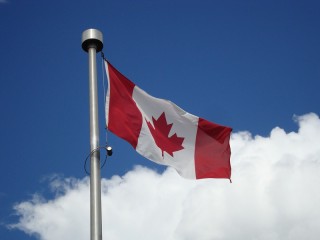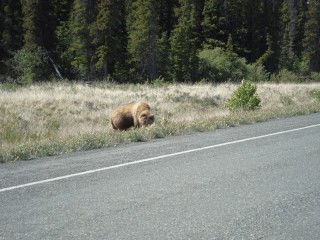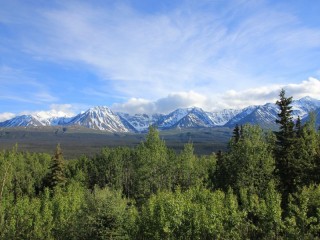From Skagway it was 2 days to Whitehorse. Right after leaving the town, the road started climbing, over White Pass. From sealevel to about 1100 meters (3292 ft) in 16 kms (10 miles) with a gradient of 8% for 9 miles. When we were almost at the top, it started raining; there even was some wet snow. So it was very cold. When we were at the top we entered sort of a moonlike landscape; arid and rocky with many little lakes. Beautiful.
A few kms after the top was Canadian Customs. When we entered the building, the first question they asked was; where are you from? She probably already knew the answer because we were wearing our orange outfits. The reason for that question was that the Dutch soccer team had just degraded Spain with 5-1. So we were updated again… We entered the country without any problems.
From the border to the little town of Carcross was pretty hard work. A constant up and down but fortunately we had tailwind. Finally lucky with the wind direction! But we did see our first bear! A black bear cub was eating at the side of the road. Fortunately, the mother wasn’t anywhere (too) close because it’s her that you need to look out for.
Carcross is the only town on the way, a little over halfway. We could stay with Laura, another address through Warmshowers. When we arrived in the town, we went to the visitor center to call Laura. We must have looked very cold, because the ladies offered us a hot cup of tea. And that felt really good!
The next day we didn’t leave too late and after a visit to the bakery for free coffee and something good to eat on the road, we started for the last kms to Whitehorse. The scenery wasn’t as spectacular as the day before, but we had tailwind again most of the way and the weather was beautiful. It was sunny and nice and warm and after a few hours of cycling, we arrived at Matts house. Matt is Laura’s boyfriend and we could stay with him. Laura arrived later that day to spend the weekend there.
It was a good weekend, with a mountainbike ride in the forests behind Whitehorse and a bbq on the last day. The town of Whitehorse is a pretty nice town with everything you might need or want. Groceries were the most important thing for us because the next stretch, to Fairbanks, would be a stretch of almost 1000 kms (600 miles) and only after about 650 kms (350 miles) would there be an opportunity to buy food again. There are a few very small convenience stores on the way, but they don’t have much and what they have is very expensive.
After 2 days in Whitehorse, we said goodbye to Matt and Laura and we left in the direction of Haines Junction. We didn’t make it that same day, but we didn’t have to because we had arranged to stay with David and Darlene the next day. It was cold and cloudy, but we had a tailwind again and we saw another bear. A Grizzly this time, the first Grizzly we ever saw. This one also was just doing its thing and eating alongside the road.
We arrived in Haines Junction the next day. David and Darlene have a beautiful, self built house with an amazing view of the snowy mountains behind the town. A place to envy.
We went on a tour through the tiny village and after a good dinner, we went out in the car to have a look around. We almost got blown away by the storm, but we did enjoy it up there.
Then there was a section with not much else than a few campgrounds. There used to be a lot more campgrounds and lodges, but many have closed because of financial reasons. People drive longer distances nowadays which makes many accommodations unneccessary. For us as cyclists it’s not very convenient. Sometimes there’s a long stretch without anything and we have to make long days to get to the next campground. Or very short days. Wildcamping is an option, there are many beautiful spot to pitch a tent. But in bearcountry, that’s difficult. Bears have very good smell and they smell everything with a scent (food, deodorant, showergel etc.) from far away. Because you don’t want a bear next to or in your tent, you need to put all that stuff somewhere where they can’t reach it. You can hang it in a tree, for example. But the trees here are very low and don’t have many branches, so over here that’s not such a good option. That’s why we’d rather stay on a campground where there aren’t many bears around or where we can store our bags somewhere inside.
After Haines Junction it started climbing again immediately, over a pass. Here, we also saw a Grizzly who was enjoying the taste of the plants on the side of the road. After the pass we descended to Kluane Lake, an area where many of the cyclists we met (it’s a popular route) had seen many bears. We also did see another one. In the first 6 days of cycling, we saw a bear on 4 of them.
Most of the days we had a tailwind (for a change) but the temperature varied a lot. One day it would be nice and sunny, the next it would be cold and cloudy. When we arrived at the Canadian/US border again, it started raining very hard. It was so cold that there was some hail in the raindrops. Fortunately it got dry again and we were able to spend the evening in the sun. After another few good days, the weather changed. It rained a lot, especially during the nights; all night long. On a rainy day, when it rained all day long, we decided to take a hotelroom. We were wet and cold and didn’t want to be in the cold the rest of the day.
The scenery varied from forest to mountains to lakes and was beautiful most of the time. The one moment we would cycle between the (low) trees and the next it would open up and we would see hills and mountains again. The last 300 kms (200 miles) were pretty boring; we didn’t see much else but trees and it was pretty flat with long straight roads. The ground is permafrost, so it never thaws. That’s why the trees are so small. They look like young trees, but they can be hundreds of years old. Because of the permafrost and the very long winters, they don’t have much time to grow.
That permafrost also causes problems with the roads. Sometimes, part of it melts away which causes that part of the road to collapse. Some parts are very bad with many potholes. People work all summer, 7 days a week, to try to fix as much as possible. The season is short, so they work all week. At many of those roadconstruction sites you’re not allowed to cycle past. We have no idea why, but they won’t let you. So the bikes had to go in the back of a pilot car and we could sit in the car, warm and dry. Unfortunately, it usually was just a very short section and it was a lot of work taking the panniers off the bikes and putting them back on.
After a few days of cycling, we were in the town of Tok; sort of a real town with a grocerystore so we could restock our supplies there. Two days later we arrived in Delta Junction, in the pouring rain. Another town with all services like a grocerystore. In Delta Junction you can see the famous Alaska pipeline which runs from the far north to Valdez in the south. Via the town of North Pole, where Santa Claus lives according to Americans, we finally arrived in Fairbanks, and it was raining again. But the next days were beautiful; dry, sunny and a good temperature. But again with some rain…
After a few days of rest on a campground in Fairbanks and with a new stack of food in our panniers, we leave again tomorrow. Next stop will be Denali National Park, a national park in the mountains with Mt. McKinley, the highest peak of North America, as major attraction. The park is also known for its large populations of wildlife like bears and moose.


















































Greetings from Sunny San Diego, California. Ed and I are enjoying your travels and photos. Keep them coming! 🙂
Weer prachtige ervaringen het houd niet op, ga zo door!! Geweldig dat jullie dat met ons willen delen. Liefs….
Weer prachtige foto’s en verhalen. Leuk om te zien en te lezen.
Wow, exciting that you have seen so many bears! Hope they continue to be cute and snuggly. Your photos look like the Patagonian landscapes all over again, but this time with pavement and not ripio 🙂 The pictures make me want to go visit my sister in Alaska even more.
Good luck with long stretches of road ahead, keep the tires on the pavement!
-E & L